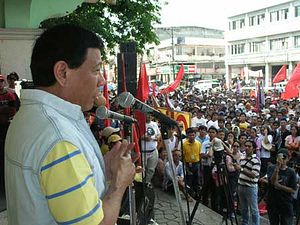Over the past week, we saw a new round of the on-again, off-again tensions between the Philippine government and communist forces. The developments marked yet another cycle in one of Asia’s longest-running insurgencies, which is among the major internal security challenges that the administration of President Rodrigo Duterte continues to face during his single six-year term out to 2022.
The struggle between the Philippine government and communist forces – specifically the Communist Party of the Philippines (CPP) along with its armed wing, the New People’s Army (NPA), whose numbers have dwindled to around 4,000 members today by some estimates – has been going on for over half a century. Over 100,000 combatants and civilians have died in the conflict since 1969, with multiple efforts at peace failing to take off across administrations. While Duterte had offered fresh hope for the process given his background in the country’s south and links to founding CPP chair Jose Maria “Joma” Sison, getting to peace has nonetheless proven elusive since he came to office back in 2016.
That pattern has continued on over the past year as well. Talks between the Duterte government and the CPP have not led to any sustained progress beyond cycles of starts and stops. Meanwhile, the NPA has continued its operations in the Philippines, presenting both a security challenge of its own but also complicating the country’s internal security environment more generally. Besides the NPA challenge, the government is also managing a peace process with the Moro Islamic Liberation Front in the south and tackling the ongoing threat of militancy and terrorism more generally from a range of groups including the Abu Sayyaf, the Maute Group, and the Bangsamoro Islamic Freedom Fighters.
Over the past few weeks, we have seen another instance of on-again, off-again tensions between the Philippine government and communists. Last week, news emerged that the government and the CPP had agreed to a ceasefire amid the global coronavirus pandemic, marking a manifestation of the “global COVID ceasefire” UN Secretary-General Antonio Guterres had called for. But in the days since, we have seen doubts cast about both the status and sustainability of the recent ceasefire and growing anxieties about a reversion to the previous cycle between all sides.
These developments come as no surprise. Beyond the Duterte administration’s approach, it is worth keeping in mind that under three of the past four Philippine administrations that had committed to peace talks before Duterte – Corazon Aquino, Gloria Macapagal-Arroyo, and Benigno Aquino III – perceived violations by both sides eventually led to a breakdown in talks amid an alternating cycle between negotiations and violence.
But the developments also reflect the broader challenges inherent in reaching peace. Irrespective of the political will among some segments in both the government and communist sides, there are divisions in both camps – with some communists uncomfortable with certain aspects of a deal with the Duterte government and the Philippine security forces and some political opponents reluctant to acquiesce to a deal that is seen as too conciliatory. It is also unclear whether both sides will have the necessary staying power to get past the obstacles they face, especially the Philippine government given the manifold security challenges it faces and the current state of COVID-19 in the country.
Of course, just because peace has proven elusive thus far does not mean that the communist insurgency in the Philippines is intractable. Crises such as COVID-19 have the potential to serve as an opportunity for peace as much as a challenge to it, depending on what the different parties choose to make of the situation. The recent inroads that the Duterte administration has made thus far with respect to the peace process with the Moro Islamic Liberation Front illustrates that one should be cautious about writing off incremental inroads toward peace even after decades of conflict. Nonetheless, the developments over the past few weeks do reinforce the difficulties of getting to peace even as both sides are getting more serious about doing so. That is important to keep in mind whenever we see waves of headlines about flickers of hope for peace.
































